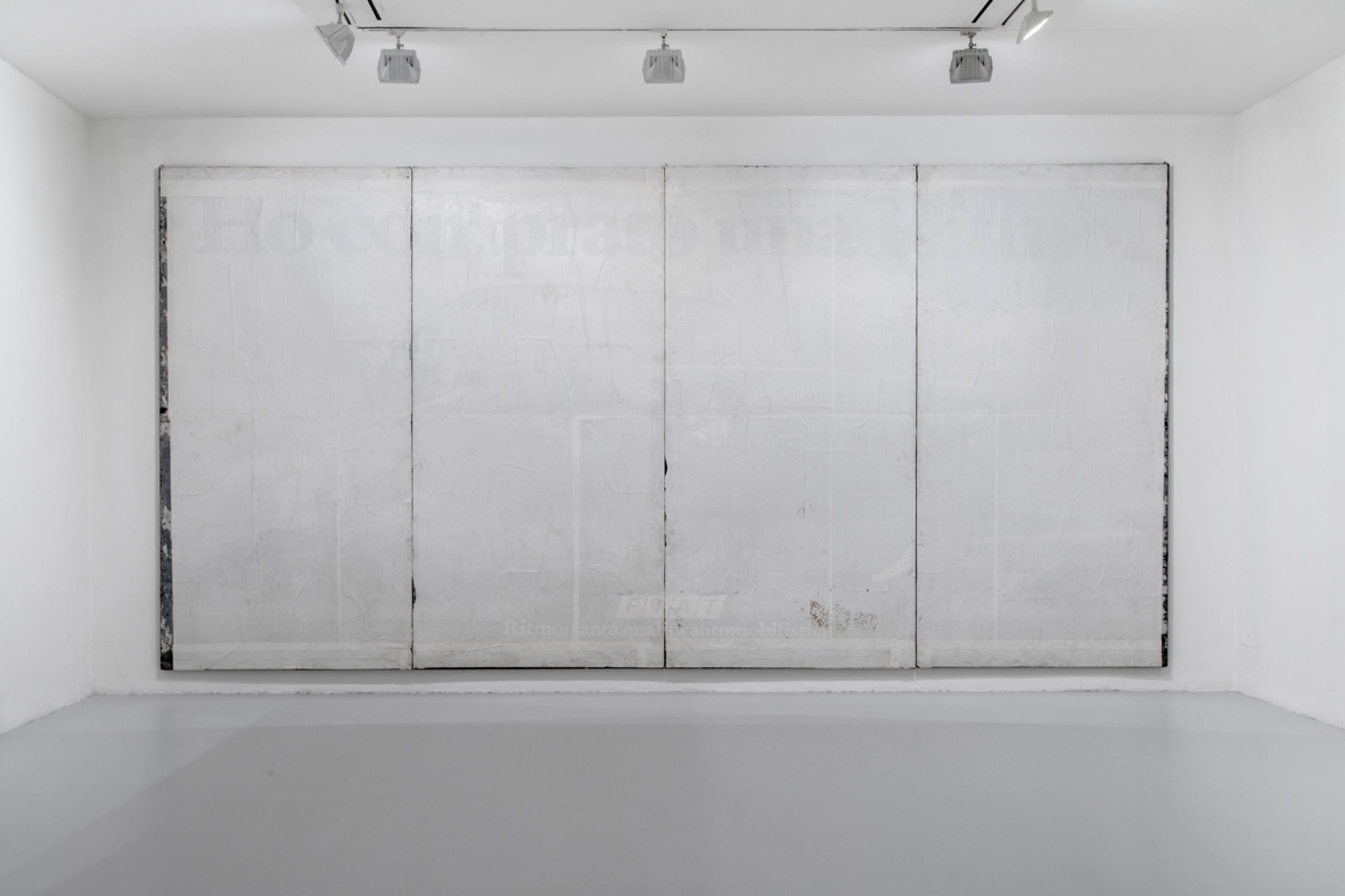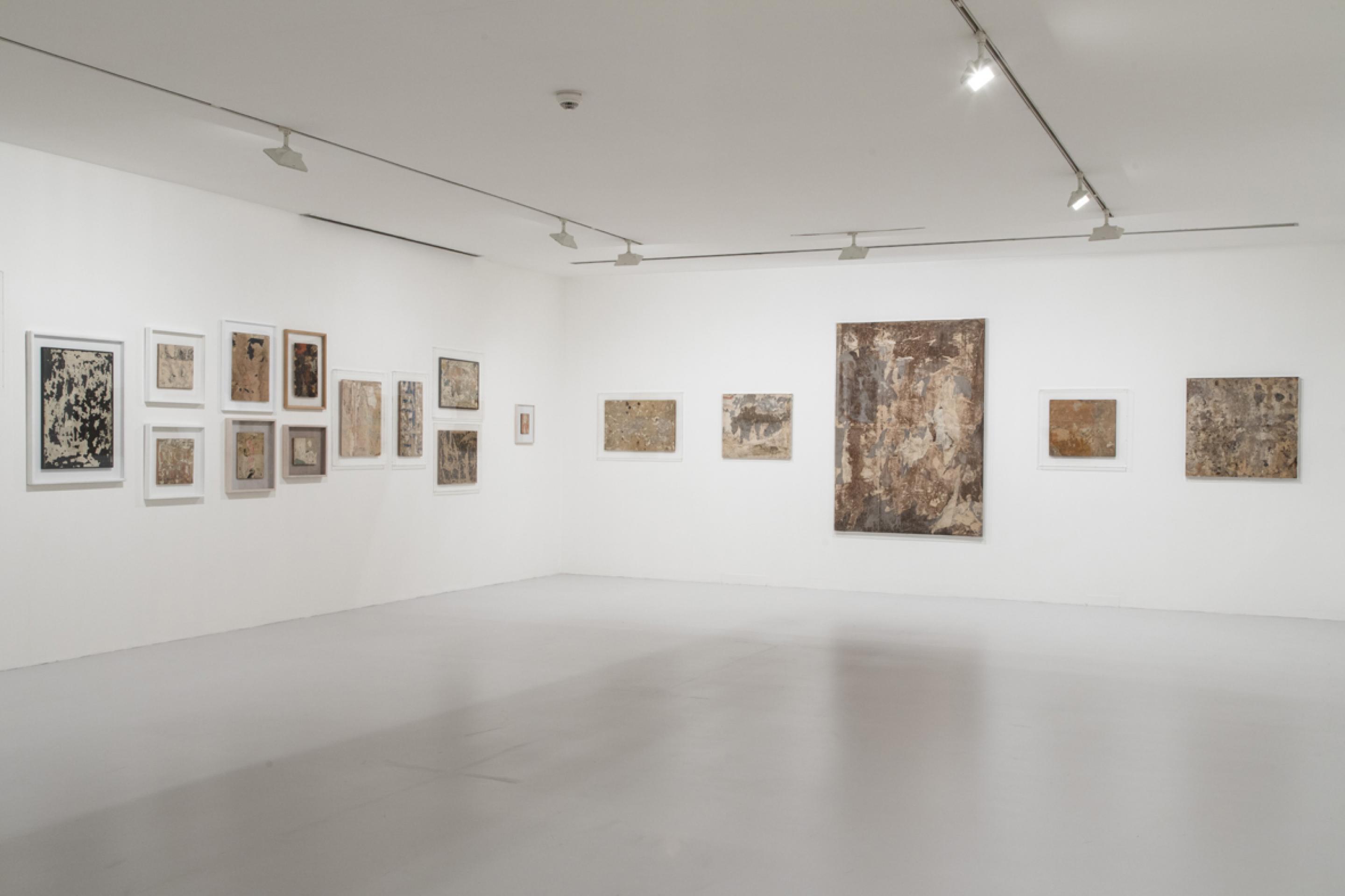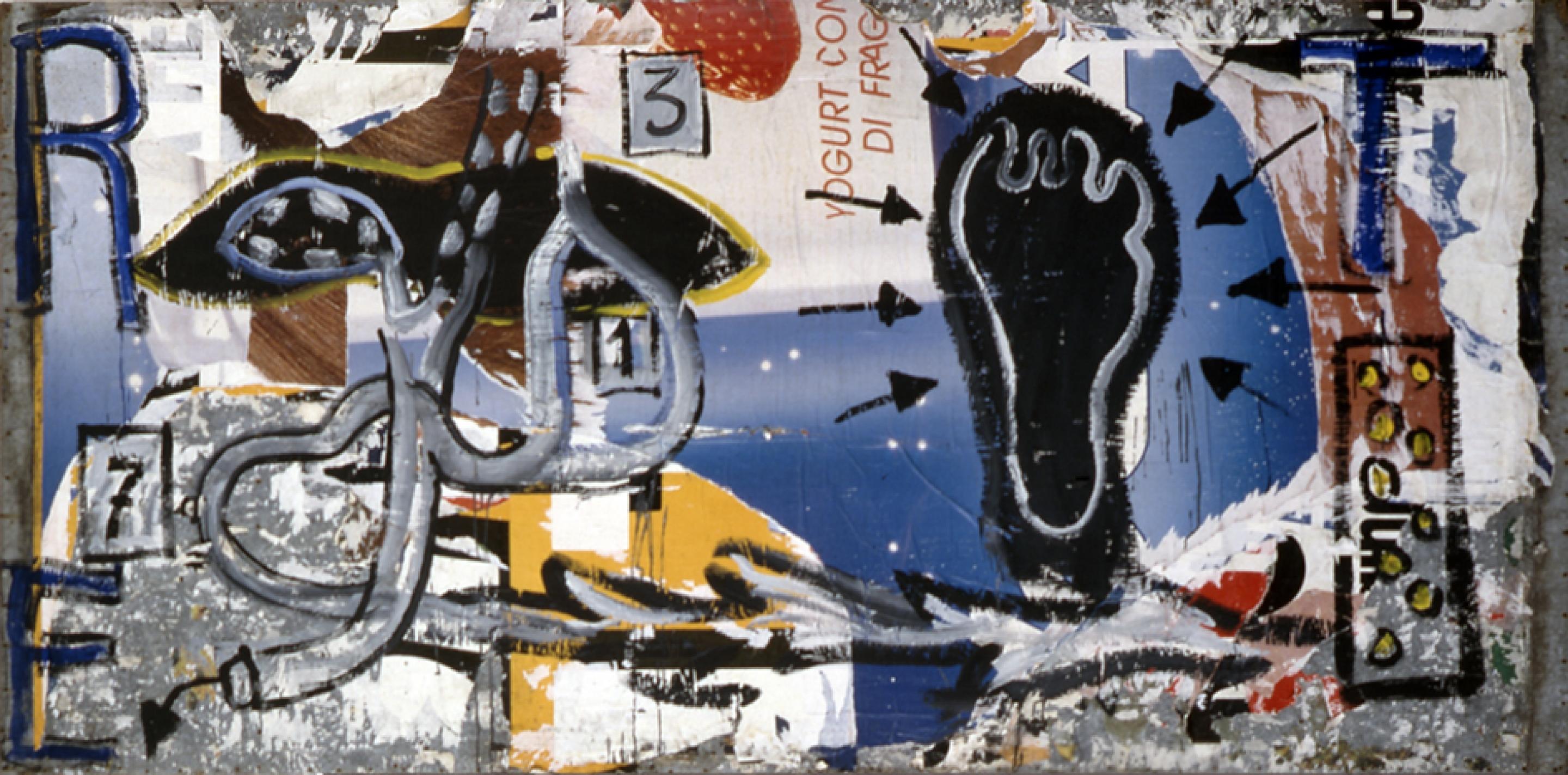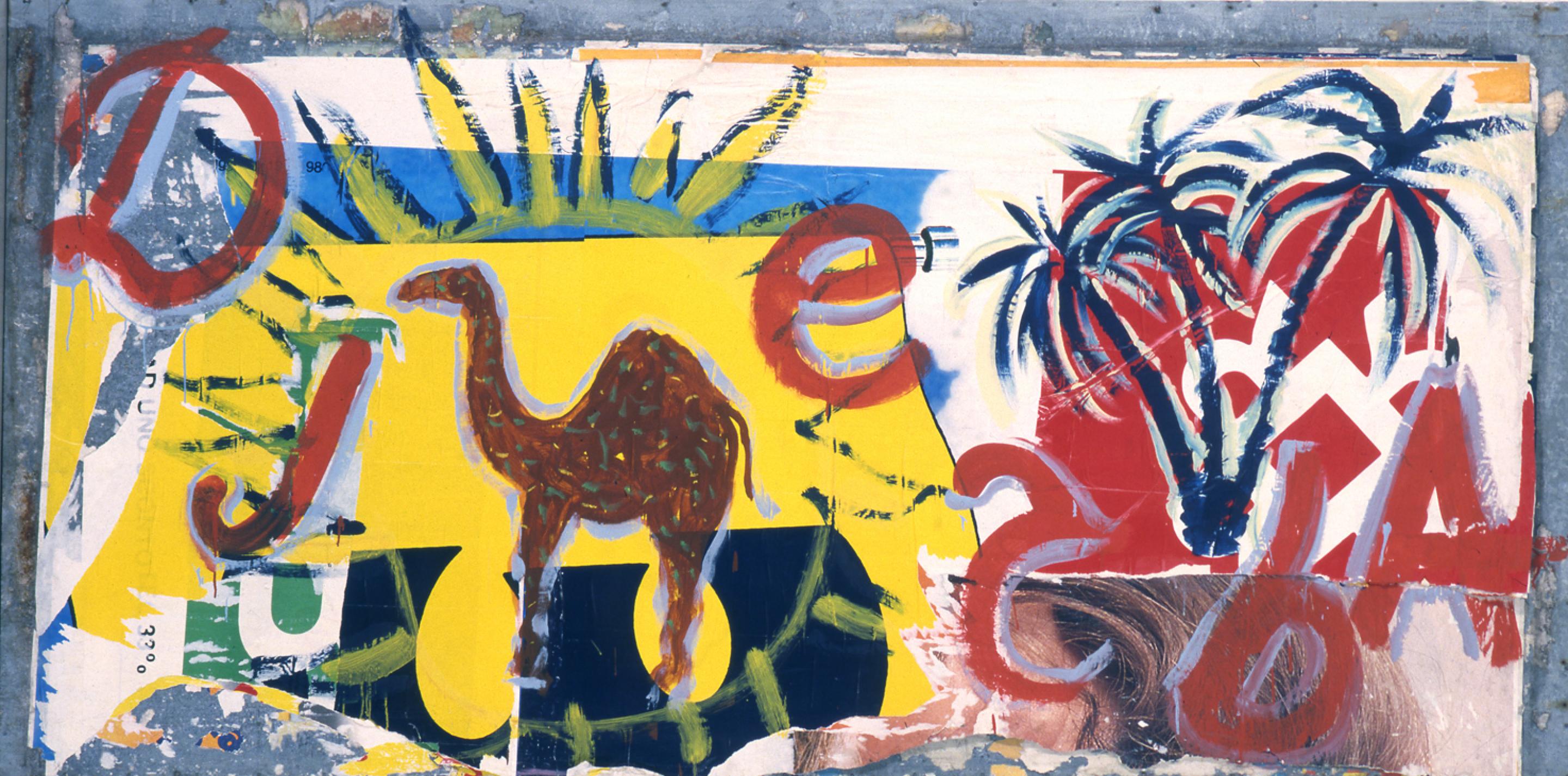MimmoROTELLA
Mimmo Rotella and Giorgio Marconi. A history of art and friendship
11.2016–02.2017
Mimmo Rotella and Giorgio Marconi. A history of art and friendship
11.2016–02.2017
1/10
Mimmo Rotella, Installation View, Mimmo Rotella and Giorgio Marconi. A history of art and friendship, Fondazione Marconi, Milan, 2016
Press Release
Mimmo Rotella and Giorgio Marconi
A history of art and friendship
Opening: November 24, 2016
November 25 – February 4, 2017
A history of art and friendship
Opening: November 24, 2016
November 25 – February 4, 2017
Only a few years after the Marconi Foundation's last exhibition dedicated to Rotella on the retro d’affiches (2013), this new show forms part of a series entitled Mimmo Rotella 2016, which began in September in different venues throughout Milan.
This fitting homage, which coincides with the tenth anniversary of Mimmo Rotella’s death (Catanzaro 1918 - Milan 2006), is promoted by the Mimmo Rotella Institute.
Set up in 2012 by Inna and Aghnessa Rotella with the aim of compiling the catalogue raisonné, improving understanding of the figure and the art of Mimmo Rotella and promoting his work at the national and international level, the Mimmo Rotella Institute is directed by Antonella Soldaini with the scientific support of Veronica Locatelli.
The Mimmo Rotella 2016 initiative intends to highlight and valorise the artist’s multifaceted work which, in addition to the famous décollages and retro d’affiches, comprises a series of experimental works based on different techniques, such as photographic reportages, artypos, effaçages, frottages, sculptures, blanks and the sovrapitture.
In the early Fifties, Mimmo Rotella was struck by the posters he saw on the walls of the Piazza del Popolo in Rome and began to appropriate them, rip them and glue them directly on canvas. Once attached to the support, he worked on them further on the front and/or back.
This process was the advent of the décollages, in other words, superimposed layers of torn paper, never randomly chosen, compiled with the intention of achieving a balanced composition, with precise relationships of colour and material.
As well as a clear expression of dissent against traditional painting, the gesture of tearing the posters was a way for Rotella to take control of an aspect of reality.
In fact, in 1960, Pierre Restany included him in the Nouveau Réalisme group.
This fitting homage, which coincides with the tenth anniversary of Mimmo Rotella’s death (Catanzaro 1918 - Milan 2006), is promoted by the Mimmo Rotella Institute.
Set up in 2012 by Inna and Aghnessa Rotella with the aim of compiling the catalogue raisonné, improving understanding of the figure and the art of Mimmo Rotella and promoting his work at the national and international level, the Mimmo Rotella Institute is directed by Antonella Soldaini with the scientific support of Veronica Locatelli.
The Mimmo Rotella 2016 initiative intends to highlight and valorise the artist’s multifaceted work which, in addition to the famous décollages and retro d’affiches, comprises a series of experimental works based on different techniques, such as photographic reportages, artypos, effaçages, frottages, sculptures, blanks and the sovrapitture.
In the early Fifties, Mimmo Rotella was struck by the posters he saw on the walls of the Piazza del Popolo in Rome and began to appropriate them, rip them and glue them directly on canvas. Once attached to the support, he worked on them further on the front and/or back.
This process was the advent of the décollages, in other words, superimposed layers of torn paper, never randomly chosen, compiled with the intention of achieving a balanced composition, with precise relationships of colour and material.
As well as a clear expression of dissent against traditional painting, the gesture of tearing the posters was a way for Rotella to take control of an aspect of reality.
In fact, in 1960, Pierre Restany included him in the Nouveau Réalisme group.
Studio Marconi was to prove a privileged vantage point for witnessing Rotella’s way of working and prolific output as it continued to change and evolve over the years.
Mimmo Rotella and Giorgio Marconi had in fact already met in the Sixties, a time when Rotella was travelling frequently between Milan and Rome. However, their long and successful association began some years later, with an important exhibition, Rotella ‘coperture’ 1980 (1981). This exhibition marked the first appearance of the blanks, which Pierre Restany defined as a “sure and attentive judge” of Rotella’s artistic evolution.
They are works that emphasise nothingness, the collapse of the poster as a source of information, signalling that their display time has definitely expired.
“In order to cancel the overlapping visual messages on billboards, the specialists cover them with a layer of plain paper, usually white. Into the folds, the ridges, the creases and cracks of this whiteness, Rotella’s appropriative instinct straightaway recognised the quality of a full emptiness, the presence of absence and a place waiting for an infinite number of images.” (P. Restany, Rotella ‘coperture’ 1980, 1981)
Just a few years later came the exhibition Cinecittà 2 Cine Rotella (1984), whose works were based on posters dedicated to Hollywood movies and Sixties films that Rotella initially re-photographed in colour, printed in the desired format and then painted.
The collaboration between Mimmo Rotella and Studio Marconi continued with a number of key exhibitions: Rotella. Décollages 1954-1964 (1986); Mimmo Rotella. Sovrapitture 1987 (1988); Lamiere, which then moved to the Show Room Castelli in Naples (1989); Avanguardia ’60 Baj, Rotella, Spoerri (1990); Mimmo Rotella. Ready Made 1990-1991 (1991); Rotella for Swatch (1994); and Mimmo Rotella. L’arte oggi (1999).
Even after the artist’s death, Fondazione Marconi continued to organise monographic exhibitions of his work, such as Mimmo Rotella. Opere 1949-1998 (2010) and Mimmo Rotella. Retro d’affiche (2013).
Today the Marconi collection includes works ranging from the first décollages of the early Fifties to the sovrapitture of the Eighties and Nineties.
This wide-ranging and important selection enables further study of Rotella’s artistic contribution, which evolved through various techniques and forms of expression throughout the course of his career. Among the works on display are Estropeado (1960), Le cachet (1960), Scotch Brand (1960), Il punto e mezzo (1962), Mitologia (1962), Viva America (1963), the great blank Untitled (1980-81), and La lezione di anatomia (1987).
Mimmo Rotella and Giorgio Marconi had in fact already met in the Sixties, a time when Rotella was travelling frequently between Milan and Rome. However, their long and successful association began some years later, with an important exhibition, Rotella ‘coperture’ 1980 (1981). This exhibition marked the first appearance of the blanks, which Pierre Restany defined as a “sure and attentive judge” of Rotella’s artistic evolution.
They are works that emphasise nothingness, the collapse of the poster as a source of information, signalling that their display time has definitely expired.
“In order to cancel the overlapping visual messages on billboards, the specialists cover them with a layer of plain paper, usually white. Into the folds, the ridges, the creases and cracks of this whiteness, Rotella’s appropriative instinct straightaway recognised the quality of a full emptiness, the presence of absence and a place waiting for an infinite number of images.” (P. Restany, Rotella ‘coperture’ 1980, 1981)
Just a few years later came the exhibition Cinecittà 2 Cine Rotella (1984), whose works were based on posters dedicated to Hollywood movies and Sixties films that Rotella initially re-photographed in colour, printed in the desired format and then painted.
The collaboration between Mimmo Rotella and Studio Marconi continued with a number of key exhibitions: Rotella. Décollages 1954-1964 (1986); Mimmo Rotella. Sovrapitture 1987 (1988); Lamiere, which then moved to the Show Room Castelli in Naples (1989); Avanguardia ’60 Baj, Rotella, Spoerri (1990); Mimmo Rotella. Ready Made 1990-1991 (1991); Rotella for Swatch (1994); and Mimmo Rotella. L’arte oggi (1999).
Even after the artist’s death, Fondazione Marconi continued to organise monographic exhibitions of his work, such as Mimmo Rotella. Opere 1949-1998 (2010) and Mimmo Rotella. Retro d’affiche (2013).
Today the Marconi collection includes works ranging from the first décollages of the early Fifties to the sovrapitture of the Eighties and Nineties.
This wide-ranging and important selection enables further study of Rotella’s artistic contribution, which evolved through various techniques and forms of expression throughout the course of his career. Among the works on display are Estropeado (1960), Le cachet (1960), Scotch Brand (1960), Il punto e mezzo (1962), Mitologia (1962), Viva America (1963), the great blank Untitled (1980-81), and La lezione di anatomia (1987).




















